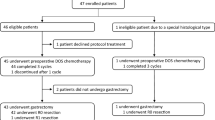Abstract
A phase I study to determine the maximum tolerated dose and toxicity of gemcitabine when given as a 24 h infusion to patients with inoperable non-small-cell lung cancer (NSCLC). A total of 24 patients with unresectable stage IIIa-IV NSCLC were entered into the study. Gemcitabine was administered as a 24 h infusion on days 0, 7 and 14. Courses of therapy were repeated every 28 days. There were 16 males and 8 females with a median age of 51 years (range 40-73 years). The WHO performance score was 1 (21 patients) or 2 (3 patients). The TNM stage was IIIa (6), IIIb (10) and IV (8). Three patients were entered at each dose level with six at the maximum tolerated dose (MTD). Dose levels were 10, 20, 40, 80, 120, 180 and 210 mg m-2. The MTD was 180 mg m-2 and dose-limiting toxicity was neutropenia and lethargy. Partial response was observed in five (21%) patients (95% CI 7-42%) lasting 10, 14, 18, 47 and 51 + weeks. The maximum tolerated dose of gemcitabine given as a 24 h infusion was 180 mg m-2.
Similar content being viewed by others
Author information
Authors and Affiliations
Rights and permissions
About this article
Cite this article
Anderson, H., Thatcher, N., Walling, J. et al. A phase I study of a 24 hour infusion of gemcitabine in previously untreated patients with inoperable non-small-cell lung cancer. Br J Cancer 74, 460–462 (1996). https://doi.org/10.1038/bjc.1996.382
Issue Date:
DOI: https://doi.org/10.1038/bjc.1996.382
- Springer Nature Limited
This article is cited by
-
Synthesis, characterization, and biological studies of some biometal complexes
Future Journal of Pharmaceutical Sciences (2021)
-
Duodenal ischemia and upper GI bleeding are dose-limiting toxicities of 24-h continuous intra-arterial pancreatic perfusion of gemcitabine following vascular isolation of the pancreatic head: early results from the Regional Chemotherapy in Locally Advanced Pancreatic Cancer (RECLAP) study
Investigational New Drugs (2015)
-
A phase II trial of prolonged, continuous infusion of low-dose gemcitabine plus cisplatin in patients with advanced malignant pleural mesothelioma
Cancer Chemotherapy and Pharmacology (2014)
-
Synthesis, characterization, and antibacterial and anticancer screening of {M2+–Co3+–M2+} and {Co3+–M2+} (M is Zn, Cd, Hg) heterometallic complexes
JBIC Journal of Biological Inorganic Chemistry (2012)
-
Regional Chemotherapy in Locally Advanced Pancreatic Cancer: RECLAP Trial
Trials (2011)




